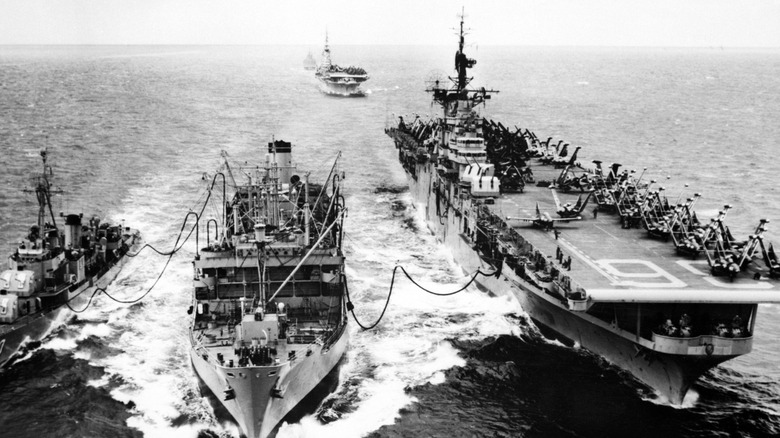How Many Aircraft Carriers Did The US Have During World War 2?
Japan's attack on Pearl Harbor gravely damaged the U.S. Navy Pacific Fleet's strength, but fortunately, no American aircraft carriers were sunk in the attack. As a result, when the United States entered World War II, it had seven fleet aircraft carriers and one escort carrier in active service.The fleet carriers are what most people hear about, as they're often at the tip of the spear of combat operations. These ships include the Lexington, Saratoga, Ranger, Yorktown, Enterprise, Hornet, and Wasp.
On the other hand, escort carriers, like the USS Long Island, are much smaller and slower carriers that are designed to give convoys air cover as well as ferry aircraft from the mainland U.S. to the front lines in Europe and the Pacific. Even though the U.S. started with a total of eight aircraft carriers, this number did not stay static for long. Of the seven original fleet carriers, the Lexington, Yorktown, Wasp, and Hornet were sunk in battle. However, the U.S.'s industrial might also played a role, massively growing the Navy's aircraft carrier fleet during the war.
The United States Built a Lot of Aircraft Carriers During World War 2
Six fleet and light carrier classes were in commission during the war, with eight more escort and training carrier classes. The entire Lexington-class and Yorktown-class carriers were already in service at the onset of World War II, as well as the single ship-class carriers Ranger and Wasp. The Essex Class is the most numerous Aircraft Carrier class in the U.S. Navy inventory, with 17 ships in service and 14 seeing combat by 1945. Its lead ship, USS Essex, was completed in 1942 and started operations in 1943. There were also the Independence-class light carriers, which were envisioned as a stopgap measure in case the Essex-class fleet carriers were delayed. These ships were converted from light cruisers, with nine ships entering service.
In total, 26 fleet and light carriers joined the U.S. Navy's ranks during World War II. However, the U.S. Navy also fielded smaller aircraft carriers. These include the Long Island-class (1), Charger-class (1), Bogue-class (11), Sangamon-class (4), Casablanca-class (50), and Commencement Bay-class (10) escort carriers, and two training carriers, the USS Sable and the USS Wolverine, stationed in the Great Lakes.
All in all, the United States had put a total of 112 aircraft carriers into service by the end of the war, with 11 lost in enemy action. That meant it had 101 aircraft carriers actively serving across the world in September 1945. By comparison, Japan started the war with 11 aircraft carriers and built 17 during the war, of which only eight entered service, revealing how the U.S.'s industrial might defeated its adversary.

